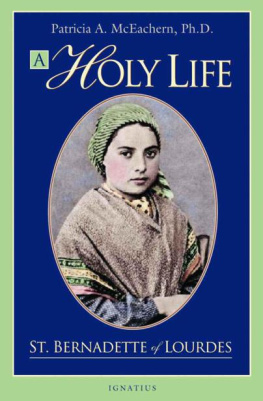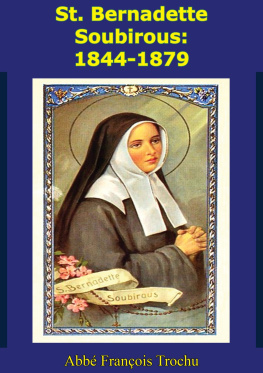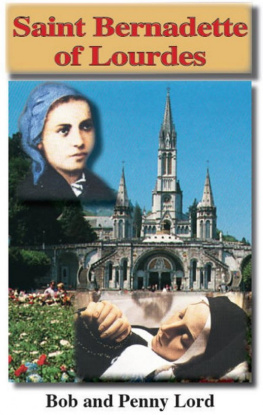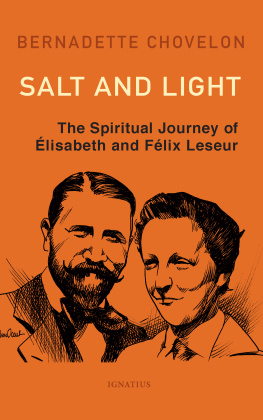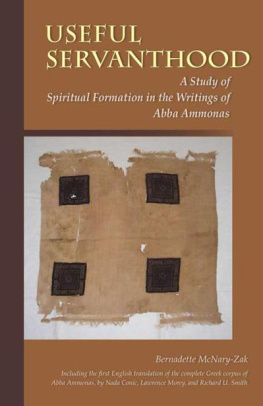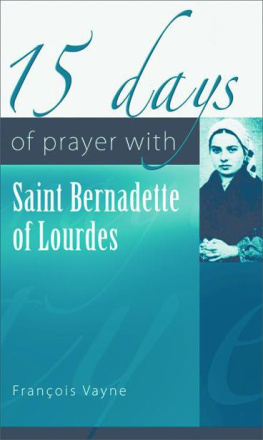A Holy Life
The Writings of Saint Bernadette of Lourdes
PATRICIA McEACHERN, Ph.D.
A HOLY LIFE
The Writings of
Saint Bernadette of Lourdes
IGNATIUS PRESS SAN FRANCISCO
Interior art:
All photographs and descriptive text in captions were provided by
the archives of St. Bernadette Institute of Sacred Art,
Albuquerque, New Mexico
Cover art: Detail of a photograph by Father Bernadou
taken in 1862 when Bernadette was eighteen
Cover design by Riz Boncan Marsella
2005 Ignatius Press, San Francisco
All rights reserved
ISBN 978-1-58617-116-2
Library of Congress Control Number 2005927347
Printed in the United States of America
For the Very Reverend
Monsignor John Henry Westhues
Priest, Spiritual Director and Friend
My soul proclaims the greatness of the Lord;
My spirit rejoices in God my Savior.
For he has looked with favor on his lowly servant.
Magnificat (Luke 1:47-48a)
CONTENTS
Journal Dedicated to the Queen of Heaven
A Holy Life: The Private Notes of Saint Bernadette of Lourdes
Bernadettes Life in Lourdes after the Apparitions: 1858-1866
Postulant and Novice at the Convent of Saint-Gildard: 1866-1867
Sister Marie-Bernard: 1867-1875
The White Chapel: 1875-1879
Pray for me, a poor sinner: April 16, 1879
ACKNOWLEDGMENTS
One of my greatest pleasures is expressing gratitude, and I enjoy a unique opportunity here to thank the many friends and colleagues who have generously assisted me in this project. Most importantly, I would like to express my great appreciation to the Very Reverend Monsignor John Henry Westhues for serving as my spiritual director and for being a steadfast example of holiness.
Pere Bertrand Ponsard, CM., of the Chapel of the Miraculous Medal, rue du Bac, Paris, has my eternal gratitude. Without his help at a crucial moment, this book would not have been written. I am extremely grateful to the Carmelite Sisters of Springfield, Missouri for their help with religious terminology, for their kindness and for their prayers. I also appreciate the hospitality and the assistance of the Sisters of Charity and Christian Instruction at Saint-Gildard Convent in Nevers, France.
A woman whom I met at a conference at Franciscan University brought Saint Bernadettes writings to my attention. Unfortunately, I do not know her name, but should she ever read these pages, I would like her to know that I am grateful to her. Larry Sloan, owner of DeSales Catholic Bookstore, and Samantha Lovetere, his gracious assistant, helped me to track down information that I needed. I also appreciate their encouragement and their interest in this project.
I am indebted to Dr. Elaine Roer Westhues and Monsignor John Henry Westhues for their help in translating Latin passages into English. Sister Barbara Dingman, of the Daughters of Charity of Saint Vincent de Paul, rue du Bac, helped me with religious terminology. I appreciate the encouragement I received from Father Mike McDevitt, Pastor of Saint Agnes Cathedral, in Springfield, Missouri. Ruben Care and Autumn, Jess, Jonah and Agnes Sweley supported this project with their prayers, their interest and their encouragement.
I would like to express my appreciation to Drury University for granting me a sabbatical to work on this project. Special thanks go to my colleagues Dr. Resa Willis, Dr. Steven Good, Dr. Charles Taylor, Dr. Rebecca Barck, Dr. Patrick Moser, Dr. John E. Moore, Kathy Daniels and the Board of Trustees for their encouragement, support and practical assistance.
I am indebted to everyone at Ignatius Press who has worked with me to bring Saint Bernadettes book to print. All have my heartfelt gratitude. Special thanks go to Father Joseph Fessio, S.J., Editor. Penelope Boldrick has my sincere appreciation for her prayers and her cheerful assistance. I appreciate the meticulous attention of the copy editor, Emily Zomberg Ayala and the proofreader as well. I thank Eva Muntean for her patience.
In addition, I am grateful for the help, support and encouragement of Most Reverend John J. Leibrecht, Bishop of Springfield-Cape Girardeau Diocese, Father Marek Bozek, Johnny Faulkner, Rosie Homan, Michael Thomas, Dr. Martine Rey Lynn McEachern, Majel Boree McEachern, Tim McEachern, Jean Peeden, Agatha Farmer, Darice Augustan, Mary Holke, Amanda Neal, Father David Hulshof, Nennele de Flores, Ann Rice, Dr. Stirling Haig, Dr. Jose Polo de Bernabe, Tynes Emory Mixon, M.D., Dr. Karl-Heinrich Barsch, and Bruno Gargiolo.
Finally and most importantly, I wish to acknowledge and thank Our Lady of Lourdes and Saint Bernadette for their intercession.
INTRODUCTION
On a cold winter day in 1858 in Lourdes, France, Bernadette Soubirous, a tiny, asthmatic shepherdess went in search of wood along the Gave River. The vision this humble young girl experienced that day has since deepened the faith of millions. Bernadette could scarcely believe her eyes when a beautiful Lady appeared before her. Eventually, she would come to understand that it was the Holy Virgin Mary herself who had appeared to her that day and on seventeen subsequent occasions. Church authorities could not have been expected to believe immediately that the Virgin Mary had appeared in a grotto where pigs took shelter from the thunderstorms that sometimes raged through the countryside surrounding the small village in the Pyrenees. Even more unlikely was that she would have enlisted the aid of a poverty-stricken, uneducated girl whose family had been reduced to living in a former jail cell condemned as too unhealthy even to house prisoners. It was highly improbable that the Immaculate Conception herself would choose this fourteen-year-old girl whose own living conditions were so very far from immaculate. Bernadette understood that the Blessed Mother had demonstrated great humility in appearing to her, conversing with her and asking for her aid, and asking so kindly and respectfully Bernadette would spend the rest of her brief life trying to follow the example of humility that the Queen of Heaven herself had shown to her.
The story of Saint Bernadette Soubirous of Lourdes has exerted a powerful influence on the spiritual lives of millions of people for a century and a half. Scores of writers, be it scholarly, religious or secular, have written about Saint Bernadette and her visions of the Holy Virgin Mary at the Grotto of Massabielle. Bernadette is typically portrayed as an honest, but illiterate and uncatechised young girl, as she was at the time of the apparitions. The catechist who prepared her for her First Communion went so far as to claim that she was incapable of learning, and Father Pomian, her confessor, accurately referred to her as a tabula rasa , that is, a blank slate. Indeed, she was thoroughly uneducated when the Holy Virgin Mary first appeared to her. Hence, it comes as a surprise even to her most ardent devotes that in reality Bernadette became a prolific letter writer; she even corresponded with Pope Pius IX to ask for his apostolic blessing. In addition to her letters, Bernadette compiled a tiny anthology of Private Notes in which she carefully recorded quotes, reflections, prayers and spiritual advice. More than any other document, her Private Notes offers a glimpse into the profound spiritual life of this most secret of saints. Her letters were not collected and published in the original French until the late twentieth century and they are translated into English here for the first time.
Saint Bernadette is as relevant, now as she was in 1858 because the message of Lourdes is conversion , and Bernadette lived that message. On August 14 and 15, 2004, Pope John Paul II made his second papal visit and pilgrimage to Lourdes to celebrate the 150th anniversary of the proclamation of the Immaculate Conception as dogma. The year 2008 marks the one hundred and fiftieth anniversary of the apparitions when the Holy Virgin appeared to Bernadette and confirmed this dogma with the words: I am the Immaculate Conception. An uncatechised tabula rasa like fourteen-year-old Bernadette Soubirous would not have heard the expression Immaculate Conception in the tiny, isolated mountain village of Lourdes. When Bernadette told Father Peyramale, her parish priest, that the Lady who appeared to her in the Grotto had identified herself with these words, he responded that she could not have said such a thing because conception is an event, and a person cannot be an event. Nevertheless, this expression is a grammatical parallel of the words of Jesus Christ himself when he said: I am the resurrection and the life. These expressions are grammatically illogical, yet spiritually true. How could an uneducated shepherdess have made such a grammatical parallel on her own, a fascinating parallel that evidently her parish priest did not recognize?
Next page
